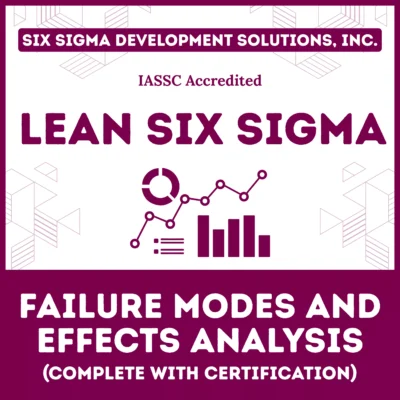E-waste, also known as electronic waste, refers to discarded electrical or electronic devices. These devices are no longer in use or have reached the end of their life cycle. This includes a wide variety of electronic gadgets such as household appliances, mobile phones, computers, televisions, and medical devices.
When these items become obsolete, broken, or out of use, we categorize them as e-waste.
E-waste includes more than just large appliances like refrigerators or washing machines. It also encompasses smaller electronic items like mobile phones, electrical cables, batteries, and circuit boards. Even components like plastic casings, cathode-ray tubes, and lead capacitors, we can consider e-waste.
As technology rapidly advances, the production of electrical and electronic devices grows, leading to an increase in e-waste.
Today, e-waste is one of the fastest-growing waste streams worldwide, increasing by about 3-5% annually. The demand for electronic products keeps rising, but the lifespan of many devices keeps shrinking due to technological innovation. This has contributed to a constant surge in e-waste generation.
Proper management of e-waste is crucial to avoid potential environmental and health issues. If improperly disposed of, e-waste can harm the environment and human health. However, if we recycle and handle e-waste properly, we can turn it into valuable resources.
Table of contents
What is E-Waste?
We often refer to electronic waste as e-waste, a term used to describe discarded electronic devices. These devices can range from personal gadgets like cell phones and laptops to larger items like refrigerators and televisions.As technology advances, we discard older devices when they become obsolete, which often leads to a pile-up of e-waste.
Why E-Waste is a Growing Concern?
The growing demand for new electronics, coupled with their relatively short life spans, contributes significantly to the rise in e-waste. Because of technological innovation, we constantly upgrade or replace devices, which makes older models obsolete much faster than in the past.
As a result, electronic products become waste much quicker than before, contributing to an annual increase in e-waste of approximately 3-5%.
Another reason e-waste is growing is the increase in electronic device sales worldwide, particularly in emerging markets. As the middle class expands, more people can afford electronics, which leads to higher consumption and consequently more e-waste.
E-Waste Composition
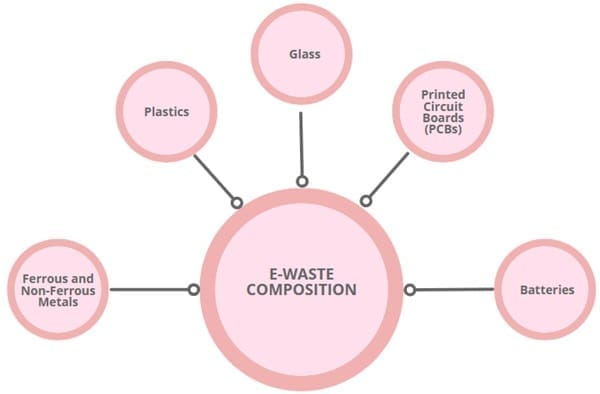
E-waste is made up of a wide range of materials that can be classified into hazardous and non-hazardous categories. Some of the major components of e-waste include:
- Ferrous and Non-Ferrous Metals: These metals include iron, steel, copper, aluminum, and precious metals like gold, silver, and platinum. These metals can be recycled and reused in manufacturing new products.
- Plastics: E-waste also contains plastics used for casing and components. We often find it difficult to recycle plastics, but we can use them to make new products once we process them properly.
- Glass: Electronic screens, such as those in televisions and computers, contain glass that may include hazardous substances like lead or mercury.
- Printed Circuit Boards (PCBs): We can find PCBs in most electronic devices. They are made of materials like copper and plastic and can contain precious metals like gold.
- Batteries: Many electronic devices contain rechargeable batteries, which often contain toxic substances like cadmium, lead, and lithium.
- Other Components: Rubber, ceramics, wood, concrete, and other materials may also be present in e-waste.
The presence of hazardous elements like lead, mercury, arsenic, cadmium, and flame retardants makes e-waste particularly dangerous if not properly managed.
Solutions and the Way Forward
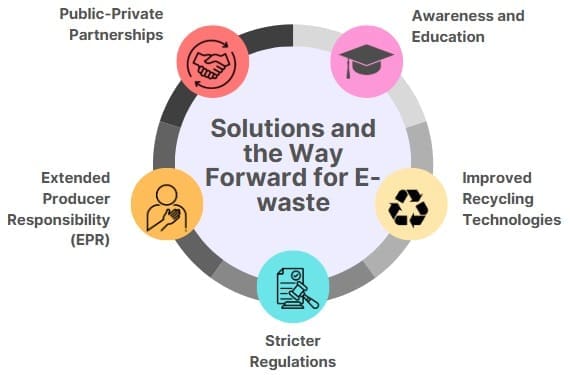
The solution to the e-waste crisis lies in better management, recycling, and disposal practices. Several steps need to be taken to mitigate the environmental and health impacts of e-waste:
- Awareness and Education: Raising awareness about the dangers of e-waste and how to dispose of it properly is crucial.
- Improved Recycling Technologies: Investing in advanced, eco-friendly recycling technologies can help recover more valuable materials while minimizing environmental harm.
- Stricter Regulations: Governments must enforce stricter regulations to ensure the safe disposal of e-waste and prevent illegal dumping.
- Extended Producer Responsibility (EPR): We should hold manufacturers accountable for the end-of-life disposal of their products, ensuring they recycle them responsibly.
- Public-Private Partnerships: Collaboration between governments, industries, and NGOs can help improve e-waste management systems.
Types of E-Waste
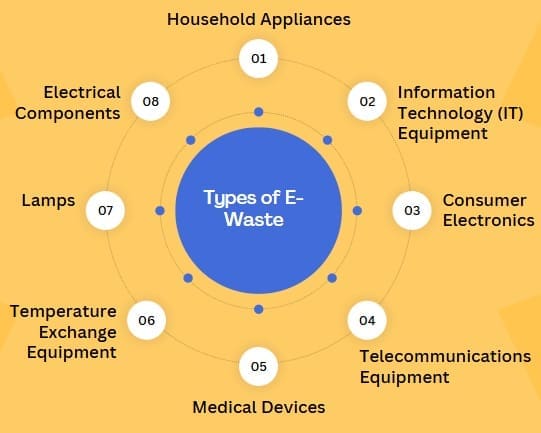
E-waste is a broad category that includes a variety of devices and components:
- Household Appliances: This includes items like refrigerators, washing machines, and microwave ovens.
- Information Technology (IT) Equipment: This category covers computers, servers, printers, and other office equipment.
- Consumer Electronics: This includes mobile phones, televisions, gaming consoles, and other gadgets.
- Telecommunications Equipment: Landline phones, mobile phones, and internet equipment fall into this category.
- Medical Devices: Outdated medical equipment, such as old monitors and diagnostic tools, also contribute to e-waste.
- Temperature Exchange Equipment: Includes air conditioners and heat pumps.
- Lamps: Includes various types of light bulbs like LED and fluorescent lamps.
- Electrical Components: Items like batteries, printed circuit boards (PCBs), and electrical cables are also considered e-waste.
When these components are no longer in use, we dispose of them. Handling them properly is vital to reduce their harmful effects.
Dangers of E-Waste
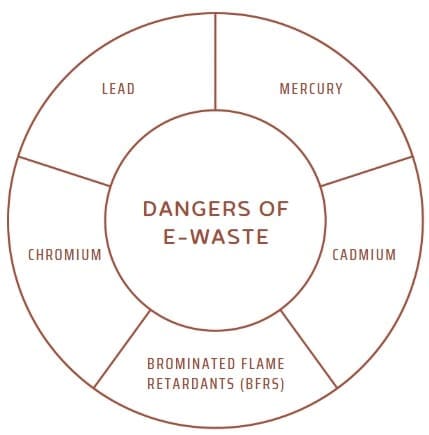
E-waste contains various hazardous materials that can pose serious threats to both human health and the environment. These harmful substances include lead, mercury, cadmium, and polybrominated flame retardants. If e-waste is not disposed of properly, these toxic chemicals can leach into the soil and water, causing long-term damage.
- Lead: Often found in old televisions and computer monitors, lead can cause neurological damage, especially in children.
- Mercury: This toxic metal is present in fluorescent light bulbs and certain electronic devices. It can cause brain and kidney damage.
- Cadmium: Found in rechargeable batteries and certain computer components, cadmium exposure can lead to kidney damage and cancer.
- Brominated Flame Retardants (BFRs): We use these chemicals to prevent fires in electronics, but they can be harmful to human health and the environment.
- Chromium: Found in certain circuit boards and cathode ray tubes.
These materials, when not disposed of properly, can leak into the environment, causing long-lasting contamination of water, soil, and air. Additionally, when burned, these materials can release hazardous fumes that contribute to both air pollution and global warming.
In addition to the direct health risks, the improper disposal of e-waste can lead to the release of toxins into the air, water, and soil. This poses a threat to wildlife and the broader ecosystem.
How is E-Waste Generated?
E-waste is generated through the life cycle of electronic products. Manufacturers use various chemicals and materials to create electronic devices. Over time, when we introduce new technology, products become outdated, which leads consumers to replace old gadgets with newer models.
This constant cycle of upgrades results in an increasing amount of e-waste. Additionally, electronic items that contain complex circuitry and multiple components, such as computers, tend to generate the most e-waste.
Health Impacts of E-Waste
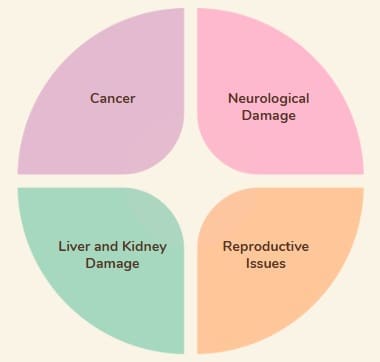
Improper handling and disposal of e-waste can lead to severe health risks. Toxic chemicals from e-waste can enter the human body through inhalation, skin contact, or ingestion. Prolonged exposure to these substances can lead to a wide range of health issues, including:
- Cancer: Certain chemicals in e-waste, such as lead, cadmium, and mercury, have been linked to an increased risk of cancer.
- Neurological Damage: Exposure to heavy metals like lead and mercury can impair brain function, particularly in children.
- Reproductive Issues: Studies have linked some e-waste chemicals, like brominated flame retardants, to reproductive and endocrine system problems.
- Liver and Kidney Damage: Metals such as cadmium can cause damage to organs like the liver and kidneys.
Furthermore, improper disposal methods such as burning e-waste in open pits or sending it to landfills can release harmful substances into the environment, leading to long-term contamination of air, water, and soil.
Environmental and Health Impacts of E-Waste
The improper disposal of e-waste leads to significant environmental pollution. When e-waste is thrown away, harmful chemicals can leak into the soil and water. These toxic materials can contaminate underground water sources, affecting plants, animals, and humans.
Furthermore, as e-waste decomposes in landfills, it can release hazardous substances into the air, contributing to air pollution.
Additionally, e-waste recycling in countries with lax regulations, like parts of Asia and Africa, has become a major environmental concern. Workers often handle e-waste without proper protection, leading to health problems like respiratory issues, skin diseases, and even long-term illnesses like cancer.
The environmental damage in these regions is severe due to improper recycling methods, such as burning e-waste, which releases toxic fumes into the atmosphere.
E-Waste Recycling and Its Benefits
While e-waste poses significant environmental and health risks, it also holds value. We can recover and recycle precious metals like gold, silver, copper, and palladium from electronic devices. If we recycle e-waste properly, we can reuse these materials, which reduces the need for mining new resources.
In fact, e-waste recycling has the potential to recover more gold and silver than traditional mining.
Recycling also prevents harmful substances like lead and mercury from entering the environment. When certified recycling centers process e-waste, they safely extract and dispose of these dangerous materials, reducing their impact on the environment.
Toxicity of E-Waste
E-waste contains many toxic substances, making it dangerous if not handled correctly. These materials can be harmful in many ways:
- Lead and Mercury: These are neurotoxic and can cause serious health issues such as developmental delays in children, brain damage, and organ failure.
- Cadmium: This metal is a carcinogen and can cause kidney and liver damage when exposed to high levels.
- Polybrominated Flame Retardants (PBDEs): These chemicals can affect hormone regulation and cause developmental problems.
The danger of e-waste becomes more serious when people do not dispose of it in a safe manner. If people burn e-waste or dump it in landfills, the toxic chemicals are released into the environment, causing significant harm to the ecosystem.
Social and Economic Impacts of E-Waste
E-waste not only affects the environment and health, but it also has social and economic implications. Informal e-waste recycling, often practiced in low-income countries, can be dangerous. Workers in these sectors are exposed to hazardous substances without proper protective equipment.
This can lead to serious health issues, including cancer, respiratory diseases, and neurological damage.
On the other hand, formal e-waste recycling can generate jobs and stimulate economic growth. Proper recycling facilities require skilled labor for sorting, dismantling, and processing the materials. The development of an e-waste recycling infrastructure can create employment opportunities, boost local economies, and improve public health.
Role of Legislation and Regulations
To address the growing problem of e-waste, many countries have introduced legislation and regulations. These laws focus on reducing the amount of e-waste generated, promoting recycling, and ensuring that people properly dispose of hazardous materials.
For example, the European Union has introduced the Waste Electrical and Electronic Equipment (WEEE) Directive, which aims to reduce e-waste generation and improve recycling rates. Similarly, countries like the United States, Japan, and China have developed their own e-waste management strategies.
Challenges of E-Waste Recycling
Despite its benefits, e-waste recycling remains a challenging issue. The sheer volume of e-waste generated each year makes it difficult to manage effectively. In 2019, the world produced a record 53.6 million metric tons of e-waste, and only about 17% of it was properly recycled. The rest of the e-waste either ends up in landfills or people process it using unsafe methods.
One of the main challenges is the lack of proper infrastructure for e-waste recycling in many parts of the world. In developed countries, such as the United States and Europe, regulations around e-waste disposal are more stringent. However, people often ship and discard e-waste improperly in many developing nations, which leads to hazardous working conditions and environmental harm.
E-Waste in the Developing World
The exportation of e-waste to developing countries, particularly in Asia and Africa, is a controversial issue. In the past, wealthy nations sent their e-waste to poorer countries under the assumption that it would be recycled. However, this has often led to the exploitation of workers and environmental degradation.
People in countries like China, India, and Nigeria, frequently process e-waste in unsafe ways, such as burning or acid baths, which releases harmful chemicals into the air and water.
The Basel Convention, an international treaty that aims to reduce the movement of hazardous waste across borders, has made efforts to curb this issue. However, illegal shipments of e-waste to developing nations continue to be a problem.
Role of Consumers in E-Waste Management
Consumers play a crucial role in the proper management of e-waste. Many people are unaware of the impact their discarded electronics can have on the environment. By taking the time to dispose of their old electronics responsibly, consumers can help reduce the amount of e-waste that ends up in landfills.
There are numerous ways consumers can contribute to e-waste management:
- Donating or Selling Old Devices: Many electronics still have life left in them. Donating or selling them can extend their usefulness and reduce waste.
- Recycling Electronics: Many cities and communities offer e-waste recycling programs where consumers can drop off old electronics for safe processing.
- Repairing Devices: Instead of discarding a broken item, consider repairing it. This reduces the need for new products and helps reduce e-waste.
Solutions for E-Waste Management
To effectively manage e-waste, several solutions must be implemented. These include:
- Stronger Regulations: Governments must enforce stricter laws regarding the disposal and recycling of e-waste. This includes holding manufacturers accountable for the end-of-life disposal of their products.
- Improved Recycling Infrastructure: The world needs to establish more e-waste recycling centers, particularly in developing countries. These centers should be equipped with the technology to safely extract valuable materials and dispose of harmful substances.
- Consumer Education: Public awareness campaigns are essential to educate consumers about the importance of e-waste recycling and responsible disposal methods.
- Design for Sustainability: Manufacturers should design products with a focus on longevity and recyclability. This could involve creating devices that are easier to repair or recycle at the end of their life cycle.
Final Words
E-waste is one of the fastest-growing waste streams worldwide, and it presents significant environmental and health challenges. However, with proper management and recycling, we can transform e-waste from a hazardous waste problem into a resource for valuable materials.
As technology continues to advance, governments, manufacturers, and consumers must work together to ensure that we dispose of e-waste in a safe and sustainable manner.By doing so, we can reduce the harmful impact of e-waste on our planet and create a more sustainable future.

About Six Sigma Development Solutions, Inc.
Six Sigma Development Solutions, Inc. offers onsite, public, and virtual Lean Six Sigma certification training. We are an Accredited Training Organization by the IASSC (International Association of Six Sigma Certification). We offer Lean Six Sigma Green Belt, Black Belt, and Yellow Belt, as well as LEAN certifications.
Book a Call and Let us know how we can help meet your training needs.
















